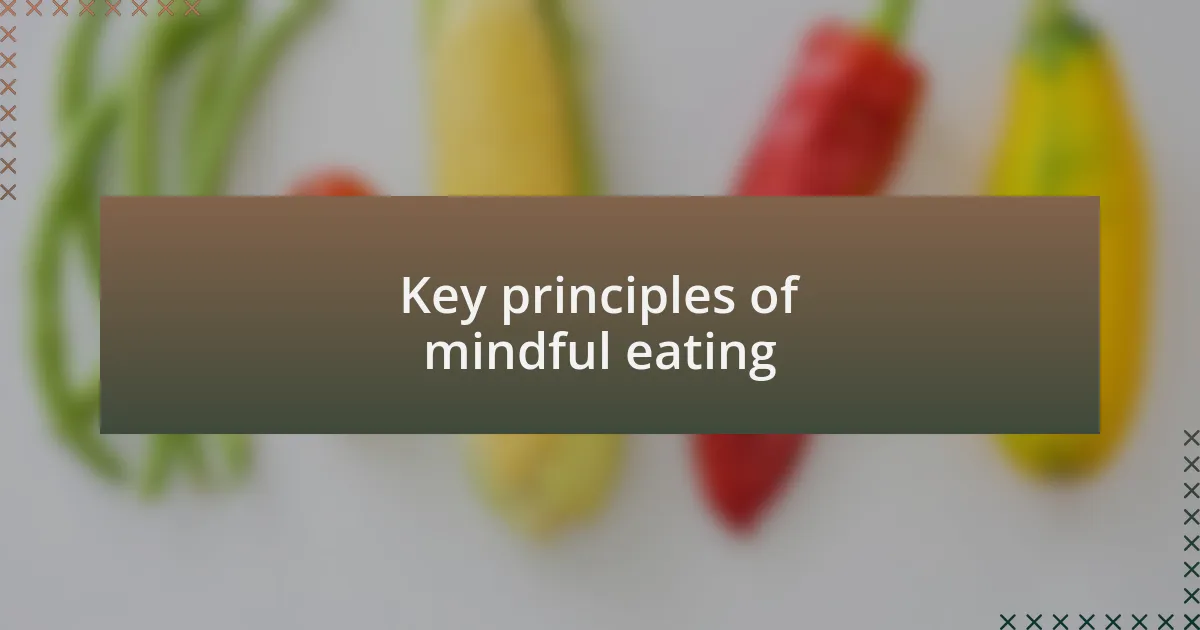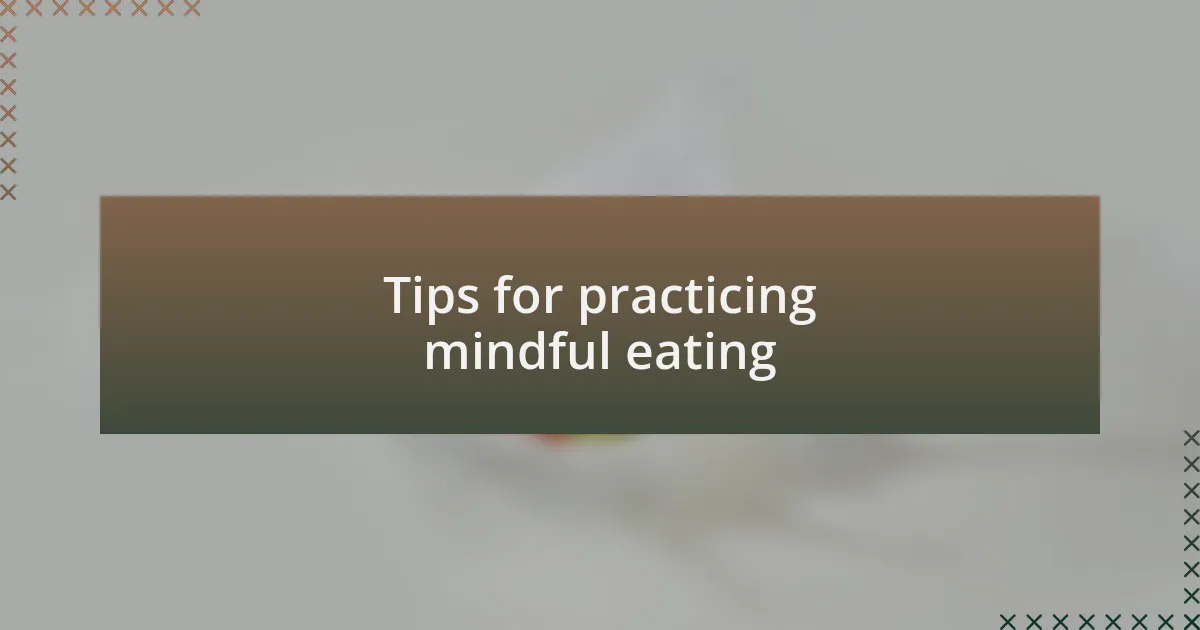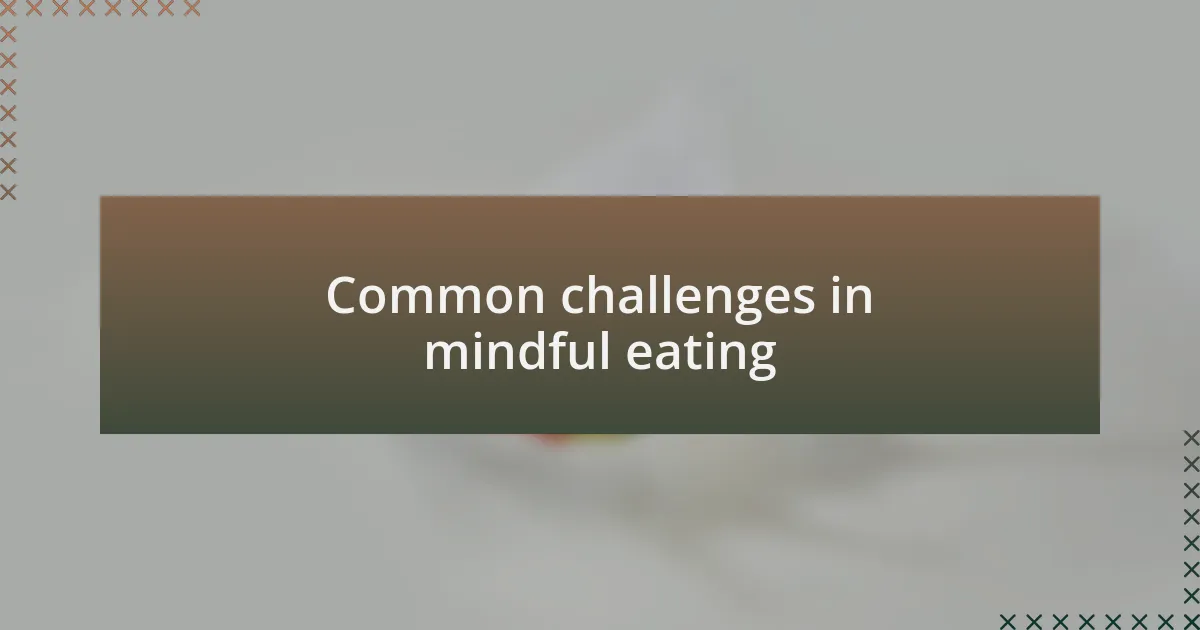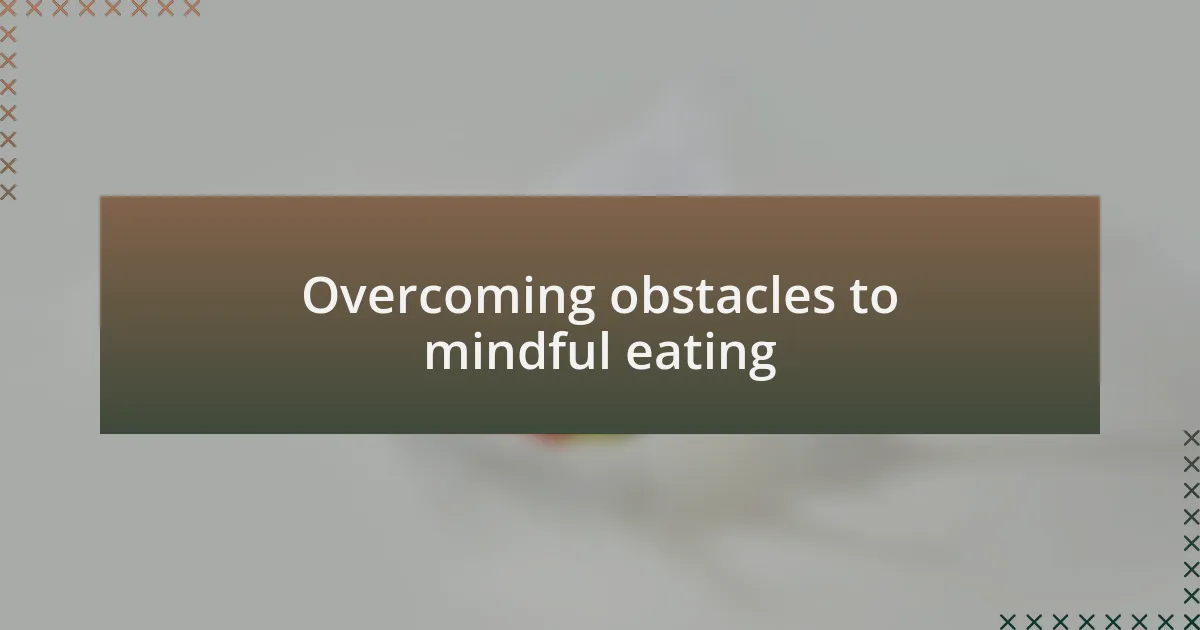Key takeaways:
- Mindful eating focuses on the experience of dining, encouraging awareness of flavors and textures while promoting a deeper connection to food and body signals.
- Practicing mindful eating enhances digestion, encourages healthier food choices, and fosters gratitude for food and its origins.
- Key principles include being present during meals, listening to hunger cues, and expressing appreciation before eating.
- Challenges to mindful eating include distractions, emotional eating, and habitual patterns, which can be addressed by creating intentional eating spaces and setting aside dedicated meal time.

Understanding mindful eating
Mindful eating is not just about what we eat but how we dine. I remember a time when I would eat my meals in front of the TV, hardly aware of the flavors or textures. Then, I decided to focus on the food itself, savoring each bite; the experience transformed my relationship with meals and taught me to appreciate the nourishment they provide.
Have you ever found yourself rushing through lunch, only to feel unsatisfied afterward? This is quite common, and it’s a signal that mindful eating is often overlooked in our busy lives. By tuning into our senses—the smell of the food, the crunch of vegetables, the sweetness of fruit—we can cultivate a deeper connection to our meals and our bodies.
Mindful eating encourages us to listen to our hunger signals, promoting awareness of when we are truly satisfied. I recall a moment when I paused during a meal, set my fork down, and took a breath. In that moment, I realized how often I ate out of habit rather than genuine hunger—it was eye-opening. By practicing mindfulness, we can turn eating into a nourishing ritual rather than a rushed chore.

Benefits of mindful eating
One of the most significant benefits of mindful eating is its ability to enhance our digestion. I’ve noticed that when I take the time to chew slowly and truly savor my food, my stomach feels lighter and more at ease afterward. It’s fascinating how just being present can trigger more effective digestion—it’s almost as if our bodies respond to our awareness.
Another aspect I love about mindful eating is how it encourages healthier food choices. I remember a time when I was about to mindlessly reach for a snack out of boredom. Instead, I paused and thought about what my body really craved. This reflection often led me to opt for something nourishing rather than a sugary treat. Isn’t it amazing how tuning into our needs can shift our decisions?
Additionally, mindful eating fosters a greater appreciation for food and its origins. When I started exploring local farmers’ markets, I realized how much love and effort goes into our meals. Now, every bite holds a story, making me more connected to my food and the environment. This appreciation not only enriches my meals but also deepens my gratitude for the resources that sustain us.

Key principles of mindful eating
The first key principle of mindful eating is awareness. This means being fully present during meals, paying attention to the flavors, textures, and aromas of the food. I’ve found that when I turn off distractions—like my phone or TV—I tend to savor each bite more. Have you ever noticed how food tastes differently when you truly focus on it?
Another essential aspect is listening to your body’s hunger cues. I’ve experienced times when I ate simply out of habit rather than hunger, only to feel overstuffed later. By tuning in to what my body actually needs, I’ve learned to distinguish between genuine hunger and emotional cravings. This practice often leads to a more balanced relationship with food.
Finally, it’s about gratitude for what we eat. I like to take a moment before each meal to appreciate where my food comes from. Whether it’s a home-cooked dish or a meal shared with friends, this reflection transforms my eating experience into a ritual of appreciation. Have you ever considered how acknowledging our food can enhance our enjoyment of it?

My personal mindful eating strategies
One strategy I’ve found incredibly helpful is creating a designated eating space. I remember a time when I would eat at my desk while working, and it was chaotic. Now, I set a cozy spot at my dining table, free from distractions, which turns my meals into a mini escape. How often do you give yourself that kind of space to enjoy your food?
Another aspect I embrace is mindful chewing. I used to rush through meals, hardly tasting anything, but now I count each chew, aiming for about 20 bites per mouthful. This sounds a bit tedious, but it’s actually transformed my eating experience. When I chew slowly, I not only enhance the flavors but also notice when I’m full, reducing my portion sizes naturally.
Lastly, I like to incorporate a mindful pause in between bites. It’s a simple practice where I set my fork down after each bite. I’ve found that this pause allows me to reflect on the taste and texture while giving my body time to register fullness. Have you ever realized how much faster you can eat without this vital moment? It often surprises me how just a few seconds can make such a difference in my meal experience.

Tips for practicing mindful eating
One tip I highly recommend is to tune into your senses during meals. When I focus on the aromas, colors, and textures of my food, it feels almost like a celebration. Have you ever really appreciated the vibrant colors of a salad or the comforting aroma of a warm bowl of soup? Engaging your senses can heighten your awareness of the eating experience and make it far more enjoyable.
I also find it immensely helpful to eat at a slower pace. There was a time when I felt rushed during lunch breaks, shoveling down food just to get back to work. Now, I’ve trained myself to savor every bite. I consciously put my fork down in between bites, allowing myself to engage in the flavors while also giving my brain time to catch up with my stomach. How often do we forget the joy of just sitting back and enjoying our meals?
Another effective strategy is to express gratitude for your food before you start eating. I’ve developed a little ritual where I take a moment to acknowledge the ingredients and the people who contributed to my meal. This practice cultivates a deeper appreciation that truly transforms my dining experience. Have you felt an emotional connection to your meals? It’s astonishing how gratitude can shift your mindset around food and enhance your satisfaction.

Common challenges in mindful eating
When it comes to mindful eating, one challenge I often encounter is the tendency to eat while distracted. I’ve had countless meals where my phone was in hand, or the TV was blaring in the background. This multi-tasking not only takes away from the experience but often leads me to overeat as I’m not fully aware of what I’m consuming. Have you ever finished a meal only to realize you hardly tasted anything?
Another common hurdle is emotional eating. There have been moments when stress or anxiety prompted me to reach for comfort foods instead of focusing on nourishing my body. I’ve learned to recognize when my cravings are driven by emotions rather than hunger, but it’s a constant battle. Do you find yourself making similar choices when feeling overwhelmed?
Lastly, I frequently face the challenge of habit-driven eating. There are times when I eat out of routine rather than genuine hunger. For instance, I used to have a snack every evening while watching my favorite show, almost like a compulsion. By becoming more aware of my eating patterns, I’ve started to question whether I’m truly hungry or just following an ingrained habit. Isn’t it interesting how often we act on autopilot without even realizing it?

Overcoming obstacles to mindful eating
One obstacle I often face is the sheer busyness of life. There are days when my schedule is jam-packed, and I find myself rushing through meals or even skipping them altogether. I’ve discovered that setting aside dedicated time for meals, even if it’s just 15 minutes, helps me reconnect with my food. How often do we prioritize everything else over something as essential as eating mindfully?
I also think about the environment in which I eat. Sometimes, my dining area is so cluttered that I can’t focus on savoring my meal. I remember a time when I made an effort to clear the table and set just one dish in front of me. That simple change turned dining into a more intentional experience. Have you ever noticed how a clean, calm space can influence your mood and appetite?
Another barrier I encounter is social situations. When dining out with friends or family, the focus can easily shift away from being present with my food. I recall an evening out where, instead of choosing a mindfully prepared dish, I got caught up in everyone else’s choices. Since then, I’ve made it a point to practice mindfulness, even in these moments. How do you navigate social settings when trying to maintain a mindful approach to eating?